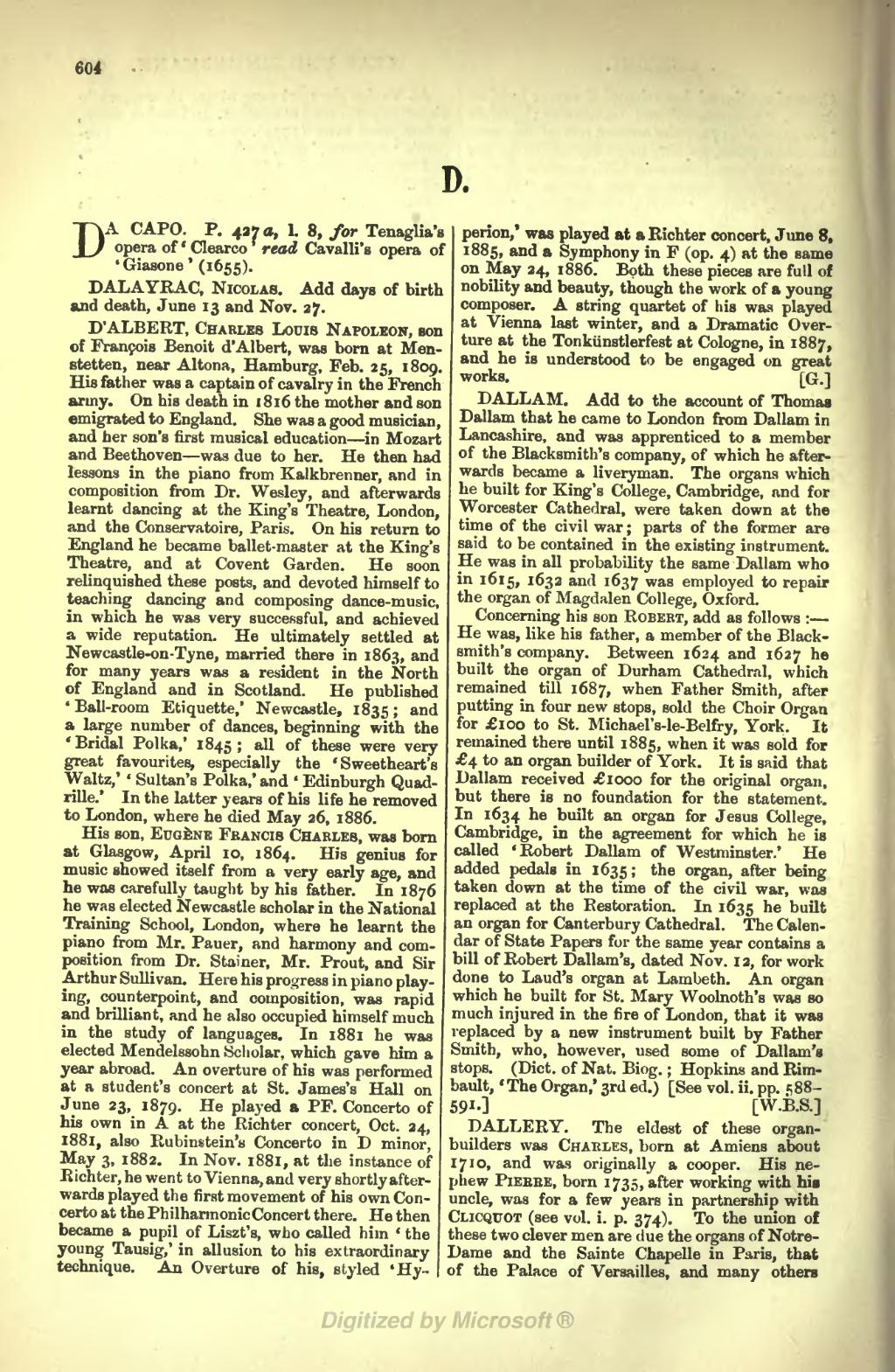D.
DA CAPO. P. 427 a, l. 8, for Tenaglia's opera of 'Clearco' read Cavalli's opera of 'Giasone' (1655).
DALAYRAC, Nicolas. Add days of birth and death, June 13 and Nov. 27.
D'ALBERT, Charles Louis Napoleon, son of François Benoit d' Albert, was born at Menstetten, near Altona, Hamburg, Feb. 25, 1809. His father was a captain of cavalry in the French army. On his death in 1816 the mother and son emigrated to England. She was a good musician, and her son's first musical education—in Mozart and Beethoven—was due to her. He then had lessons in the piano from Kalkbrenner, and in composition from Dr. Wesley, and afterwards learnt dancing at the King's Theatre, London, and the Conservatoire, Paris. On his return to England he became ballet-master at the King's Theatre, and at Covent Garden. He soon relinquished these posts, and devoted himself to teaching dancing and composing dance-music, in which he was very successful, and achieved a wide reputation. He ultimately settled at Newcastle-on-Tyne, married there in 1863, and for many years was a resident in the North of England and in Scotland. He published 'Ball-room Etiquette,' Newcastle, 1835; and a large number of dances, beginning with the 'Bridal Polka,' 1845; all of these were very great favourites, especially the 'Sweetheart's Waltz,' 'Sultan's Polka,' and 'Edinburgh Quadrille.' In the latter years of his life he removed to London, where he died May 26, 1886.
His son, Eugène Francis Charles, was born at Glasgow, April 10, 1864. His genius for music showed itself from a very early age, and he was carefully taught by his father. In 1876 he was elected Newcastle scholar in the National Training School, London, where he learnt the piano from Mr. Pauer, and harmony and composition from Dr. Stainer, Mr. Prout, and Sir Arthur Sullivan. Here his progress in piano playing, counterpoint, and composition, was rapid and brilliant, and he also occupied himself much in the study of languages. In 1881 he was elected Mendelssohn Scholar, which gave him a year abroad. An overture of his was performed at a student's concert at St. James's Hall on June 23, 1879. He played a PF. Concerto of his own in A at the Richter concert, Oct. 24, 1881, also Rubinstein's Concerto in D minor, May 3, 1882. In Nov. 1881, at the instance of Richter, he went to Vienna, and very shortly afterwards played the first movement of his own Concerto at the Philharmonic Concert there. He then became a pupil of Liszt's, who called him 'the young Tausig,' in allusion to his extraordinary technique. An Overture of his, styled 'Hyperion,' was played at a Richter concert, June 8, 1885, and a Symphony in F (op. 4) at the same on May 24, 1886. Both these pieces are full of nobility and beauty, though the work of a young composer. A string quartet of his was played at Vienna last winter, and a Dramatic Overture at the Tonkünstlerfest at Cologne, in 1887, and he is understood to be engaged on great works.
DALLAM. Add to the account of Thomas Dallam that he came to London from Dallam in Lancashire, and was apprenticed to a member of the Blacksmith's company, of which he afterwards became a liveryman. The organs which he built for King's College, Cambridge, and for Worcester Cathedral, were taken down at the time of the civil war; parts of the former are said to be contained in the existing instrument. He was in all probability the same Dallam who in 1615, 1632 and 1637 was employed to repair the organ of Magdalen College, Oxford.
Concerning his son Robert, add as follows:—He was, like his father, a member of the Blacksmith's company. Between 1624 and 1627 he built the organ of Durham Cathedral, which remained till 1687, when Father Smith, after putting in four new stops, sold the Choir Organ for £100 to St. Michael's-le-Belfry, York. It remained there until 1885, when it was sold for £4 to an organ builder of York. It is said that Dallam received £1000 for the original organ, but there is no foundation for the statement. In 1634 he built an organ for Jesus College, Cambridge, in the agreement for which he is called 'Robert Dallam of Westminster.' He added pedals in 1635; the organ, after being taken down at the time of the civil war, was replaced at the Restoration. In 1635 he built an organ for Canterbury Cathedral. The Calendar of State Papers for the same year contains a bill of Robert Dallam's, dated Nov. 12, for work done to Laud's organ at Lambeth. An organ which he built for St. Mary Woolnoth's was so much injured in the fire of London, that it was replaced by a new instrument built by Father Smith, who, however, used some of Dallam's tops. (Dict. of Nat. Biog.; Hopkins and Rimbault, 'The Organ,' 3rd ed.) [See vol. ii. pp. 588–591.]
DALLERY. The eldest of these organ-builders was Charles, born at Amiens about 710, and was originally a cooper. His nephew Pierre, born 1735, after working with his uncle, was for a few years in partnership with Clicquot (see vol. i. p. 374). To the union of hese two clever men are due the organs of Notre-Dame and the Sainte Chapelle in Paris, that of the Palace of Versailles, and many others
